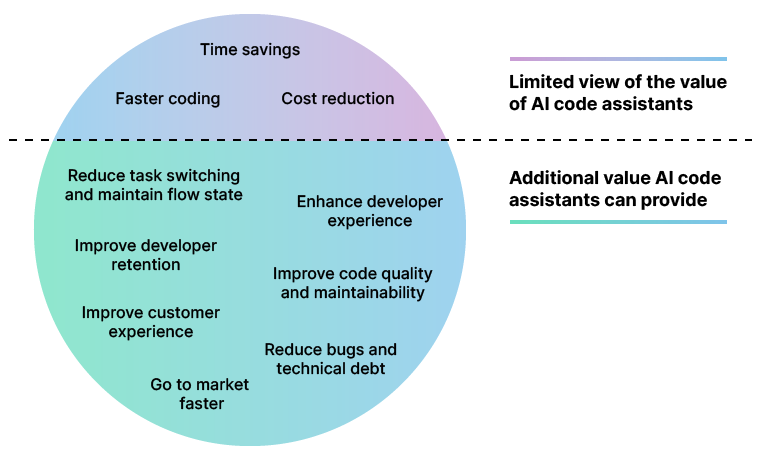Generative AI tools such as Microsoft Copilot are revolutionizing software development but also pose new security risks. Familiarize yourself with copilot security concerns and master best practices to minimize the risk of data privacy or security incidents.
In this article, we’ll take a look at:
- What AI-assisted coding is, and Microsoft Copilot specifically
- Some examples of AI-assisted coding
- Enterprise-based LLMs for coding
- Potential vulnerabilities with AI-assisted coding
- 6 best practices to remedy copilot security issues
- Risk management and data protection best practices
In AI-assisted coding, engineers leverage artificial intelligence to automate repetitive coding tasks and get intelligent code suggestions. According to a Gartner survey on Generative AI in Software Engineering Teams, more than half of software engineering departments used generative AI as of early 2024.
In that same report, Gartner found that AI security issues and privacy concerns pose significant barriers to entry for AI-assisted coding. Among the 45% of organizations not using generative AI for software engineering as of early 2024, 76% cited security, vulnerability, and risk concerns, and 71% cited worry about results such as inaccuracy and bias.

Source: Gartner Peer Community
Staying competitive in the evolving tech landscape means putting to use new tools, but not at the cost of security and privacy.
Are Microsoft Copilot security concerns keeping you from taking full advantage of AI-assisted coding? Read on to learn more about the rise of AI-assisted coding, data privacy concerns with Microsoft Copilot (or other LLM copilots), and best practices for risk assessment and data protection to get the most out of this cutting-edge technology without unnecessary security risk.
Examples of AI-assisted coding
AI-assisted coding changes the game with its ability to write and optimize code efficiently, but that’s not all. Generative AI also serves as a coding buddy for engineers, answering questions and helping them come up with innovative solutions.
With some AI-assisted coding tools, engineers can integrate the AI into their own apps.
- Automating menial or tedious tasks. To get things started, an engineer can use generative AI to build out an app’s basic framework and skip to the more interesting parts of app development.
- Understanding code and low-code functions. AI tools can show and explain source code in various formats, explain functions, and make it easy to copy and paste code for sharing.
- Navigating complex data models. AI-assisted coding can help engineers explore and produce tables to support data-rich apps. For example, Copilot can work with models in Excel, Sharepoint, or natural language.
- Integrating AI-driven features in mobile apps. App developers can build Microsoft Copilot into AI-powered apps, such as natural language question-answering, barcode scanning, and location services for end users.
Enterprise-based coding LLMs
If you’re looking for a coding LLM for your business, you’ll want a tool that balances robust performance, scalability, and security.
Like any enterprise software, enterprise LLMs are designed to integrate with large-scale business environments. Most also offer robust support and advanced capabilities for software development.
Here are some of the best coding LLMs available, including open-source options:
- Microsoft Copilot: Built on OpenAI technology and integrated into Microsoft 365, the Edge browser, Bing search, and more, Microsoft Copilot offers a variety of functions to assist business operations across the enterprise, including coding.
- OpenAI Codex: Known for its integration with GitHub Copilot, OpenAI Codex excels in generating code snippets, translating code between languages, and providing real-time code suggestions. This tool integrates with various IDEs.
- Hugging Face Transformers: Hugging Face provides a wide range of pre-trained models, including those optimized for coding tasks. Their library supports multiple languages and frameworks, and their community-driven approach ensures continuous updates and improvements.
- EleutherAI’s GPT-Neo: An open-source alternative to OpenAI’s models, GPT-Neo offers high performance and flexibility. It’s suitable for enterprises looking to customize their models without the constraints of proprietary software.
- Google’s Gemini: Once known as Bard, Gemini is designed to be more advanced and adaptable than Google’s previous LLM models. Gemini can be fine-tuned for specific coding tasks, which is handy for enterprise applications.
Importance of enterprise-based coding LLMs

Given the proliferation of free, freemium, and homemade LLM models, it’s important to remember that AI-assisted coding is a sensitive activity. An LLM that may be fine for helping hobbyists write code is not necessarily suitable for your business.
Choosing the right coding LLM for your enterprise is about more than model size or power. It’s crucial to consider data privacy, compliance with industry regulations and data rules, and how well the model will scale and integrate with your existing systems.
Enterprise-based LLMs offer tailored solutions that address these concerns. When you choose an enterprise solution, you’ll know it has robust security features and support for large-scale deployments.
Open-source options provide advanced users with additional flexibility. You can customize open-source models to meet specific needs. These tailored models help ensure alignment with your business objectives in ways that out-of-the-box AI models can’t.
Integrating the right model can improve productivity, improve code quality and facilitate a more efficient development process while maintaining stringent security and compliance standards.
Potential vulnerabilities of coding with LLMs
While using LLMs for AI-assisted coding tools introduces new efficiencies and capabilities in software development, it’s not all good. These AI tools can come with potential vulnerabilities. Points to consider:
- Outdated coding repositories. If the model you’re using pulls data from outdated or compromised code, the AI might suggest using vulnerable code snippets.
- Hijacked coding repositories. If bad actors have compromised the repositories your LLM accesses, the AI could introduce malicious code into your project.
- Security risks in enterprise LLM solutions. With fewer security protocols, non-enterprise solutions may be more vulnerable to data breaches than enterprise solutions.
- Security risks in non-enterprise LLM solutions. While enterprise-based coding LLMs are designed with additional layers of security to meet the high standards of corporate businesses, data leakage has been known to occur.

Microsoft’s Copilot takes flight
Microsoft Copilot, formerly Bing Chat, stands out as a versatile large language model (LLM) embedded right into the Microsoft ecosystem. Users can use it in Microsoft’s Edge browser, Bing search, mobile app, or built-in tool in Windows.
In his CNET review of Microsoft Copilot, Imad Khan says, “Microsoft Copilot is excellent. And it should be, right? It’s powered by GPT-4 and GPT-4 Turbo and has access to Bing’s search data to help bolster its generative capabilities.”
OpenAI’s ChatGPT chatbot can already translate software code from one language to another. Copilot offers businesses a quick and easy route to this technology to transform and modernize code development.
Microsoft introduced Copilot to Microsoft Power Apps in early 2023. As of Q1 2024, more than 25 million monthly users leveraged Power Apps.
6 best practices to secure Microsoft Copilot (and other LLM-based copilots)
Microsoft Copilot is an AI-powered assistant integrated into Microsoft 365, enhancing productivity tools like Word and Excel. It is designed for broader enterprise use beyond coding, providing AI assistance across various business functions. While it supports enterprise environments, it is not specifically a coding LLM.
If you are going to use Microsoft Copilot for AI-assisted coding, here are six best practices to be mindful of—each more critical than the last:
1. Protect intellectual property
Data protection rules can alleviate data privacy concerns with Microsoft Copilot — and other AI copilots. Establish clear guidelines on IP ownership, usage rights, and data protection. Measures including code obfuscation, encryption, and secure data storage can help ensure data privacy and protect sensitive information. Learn more about balancing data rules such as GDPR and AI innovation.
2. Implement automated testing
Automate testing across teams and projects to catch potential security issues. Automated tests, including unit, integration, and security tests, should be part of the development pipeline. These tests can continuously monitor the codebase for security vulnerabilities and functional issues, providing real-time feedback to developers. Gartner survey respondents emphasize this approach in Peer Insights on Generative AI.
3. Validate LLM output like third-party code

Your organization should review and validate external code components for potential security risks. Treat AI-generated code like any third-party code and validate it before trusting it. This means establishing a robust process for third-party code validation, including checking for known vulnerabilities and ensuring compliance with security standards like the NIS 2 Directive.
4. Use separate, impartial security tools
Use security tools within your IDE to scan AI-generated code for vulnerabilities. Integrating static code analysis, dynamic analysis, and other security scanning tools can help identify vulnerabilities early in the development cycle. These tools act as an additional layer of security, ensuring that AI-generated code meets all security standards.
5. Educate developers
Teach your developers about the risks and limitations of the AI software they’re using. In a Swiss Cheese risk management model, raising developers’ awareness about the inherent dangers of AI-generated code adds a layer of risk assessment. Training sessions, workshops, and continuous learning opportunities can give developers the knowledge to identify and mitigate potential security issues.
6. Implement robust human checks and validation processes
Keeping a human in the loop is the best practice for AI-assisted coding, meaning all AI-generated code undergoes thorough human review and validation. Developers should not solely rely on AI outputs or even automated checks. Outputs must be cross-checked manually. That way, developers can catch potential errors or security flaws that AI might miss.
Regular code reviews, peer reviews, and incorporating feedback loops are essential to maintaining the software’s integrity and security. For more detailed guidance, you can refer to Intellias cybersecurity consulting services.
Final thoughts: secure Microsoft Copilot for real productivity
Adopting AI-assisted coding tools can visibly improve productivity and optimize software development processes. Microsoft Copilot distinguishes itself in this arena, offering robust enterprise-level security and incorporating OpenAI’s advanced language models. Moreover, its seamless integration with the Microsoft ecosystem makes it yet another asset for developers aiming to enhance their workflow efficiency.
So don’t let data privacy concerns with Microsoft Copilot stop you from using this tool for AI-assisted coding. To keep your data secure, Microsoft Copilot just needs to be used within clear guidelines and robust security practices.
By following the six best practices above, engineers can minimize risks and enhance the security of AI-generated code. Formalizing data protection rules, educating your developers about data privacy, and establishing human-in-the-loop validation to alleviate Microsoft Copilot privacy concerns. Implementing automated testing, validating LLM output, and using separate impartial security tools in your IDE will address other copilot security concerns. To stay ahead in AI security and compliance, brush up on cloud security governance and explore our cybersecurity consulting services.


